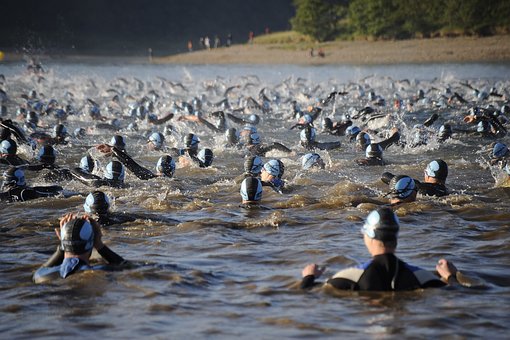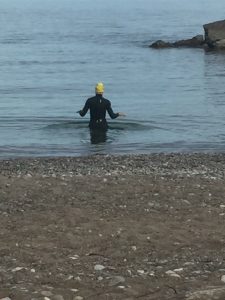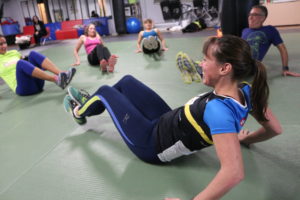For new triathletes, and for some more experienced triathletes, the prospect of getting into open water each year brings with it some anxiety. It’s not so much the fear of what lurks beneath those dark waters…it’s the memory of past negative experience or fear of having a panic attack that can linger.
Translating pool training to the lake can be unsettling for a number of reasons. First – the wetsuit. Suddenly your body has lost its sense of balance in the water because hips and legs are more buoyant. It’s a good thing, but it’s new – and can make your stroke feel different enough to be disconcerting at the start.
Add to that the water temperature – which is guaranteed to be cold at the start of the season. Especially this season! Some people find they get a headache from the cold. Others have a more dramatic reaction, which can trigger anxiety or panic attacks that result in difficulty breathing or feeling dizzy or nauseous.
Next – waves, currents and temperature fluctuations. Choppy water and waves takes a bit more strength to navigate. Finding the rhythm of the waves for breathing and sighting takes practice, and the ability to calm down enough to go with the flow can be difficult to achieve when the water conditions are more challenging. Even a sudden change in water temperature from a current can interrupt achieving a ‘zen’ zone.
Sighting is an extra step that isn’t required in the pool, and can raise anxiety because it interrupts the familiar stroke pattern and body position with that additional step. Practicing in the pool beforehand is worth the effort to work out how it fits into your rhythm, but expect it to feel very different when in open water…mainly because the distance of a marker is much further away.
Finally – people, plants and ‘pets’. While swimming with a group is desirable from a safety and race training perspective, mixing it up with flailing arms and kicking feet when you are face-first into it can send people into self-defence mode. That translates to stopping and adjusting course to avoid it (flight), or getting even by punching back (fight) out of fear or anger. When the attack comes from water plants from below or floating on the surface – it takes some nerve to ignore the stuff and carry on. Critters below the water such as fish or turtles are usually just part of the passing scenery, but turning to breathe and realizing a goose is right beside you can be a real shocker. None of these pose real threats, but can contribute to the anxiety of an open water swim.
How to Handle It?
A lot of confidence comes from knowing you can swim the distance in the pool without question. Heading into a marathon with a 36km training run as the longest you’ve ever done and gutting out the last 6km works for running, but it isn’t advised for swimming. If anything, over swim the distance of your race so you know you can do it.
Quickly escalated breathing and heart rate are common triggers for anxiety or panic attacks in the water. It helps to do some warm ups before getting in – something that will raise your heart rate a few times so your body has a chance to adapt to the climbing heart rate. Running up and down some hills, doing some fast starts in the water for short distances, jumping jacks, arm swings…any of these will help before starting off on the swim.
The right gear helps eliminate technical challenges. That means having a wetsuit that is the proper size for you, and knowing how to put it on correctly. When it is too small, or not pulled up high enough to your crotch and armpits, the feeling of being pulled down or strangled is very real. In very cold temperatures (air or water), having a neoprene swim cap and booties can help – or try wearing two swim caps. Some people claim that a coating of Vaseline on the face can help insulate the skin against the cold water. Goggles should have a tinted lens for sun protection and fit without leaking. The cold water can also cause them to fog up, which can be prevented by rinsing them with a small drop of hand soap in advance…or good old fashioned spit, in a pinch.
Once in the water, take a deep breath and let some water into the front of the wetsuit at the neck. It will be cold at first, but your body temperature will warm it quickly, and this forms a layer of warmer water as insulation. Get your face and head under water a few times and keep bobbing to become accustomed to the temperature. Get horizontal and do some breast strokes to get a feel for the water, especially if there are waves.
Start swimming at an easy pace, and focus on looking for ways to calm down. Get out of your head by counting strokes or breaths. Push aside negative thoughts like “I hate this. I want to stop. I’m afraid….etc.” Change the messaging to “I can do this. Just keep going. I’m okay. This is fine.” Focus on the cues for your stroke…’Elbows bent, catch and vertical forearm; brush the thigh with the thumb; all the breath out in the water; rotate from the hips etc.’
Sometimes the panic feeling starts after a few minutes or several hundred meters out. Take a pause to re-set and catch your breath, tell yourself everything is fine, focus on an easy stroke and start counting or working on your stroke cues. Getting out of your head and focusing on your body helps to establish a rhythm that will help you settle in and start to go with the flow. Doing a little bit of side stroke or breast stroke can help by keeping you moving forward and keeping the heart rate building at a more comfortable pace until you feel ready to return to swimming.
As with anything new or uncomfortable, the more it’s practiced, the easier it becomes. A bad experience the first time out can be a deterrent, and sometimes it takes courage to go back again and again. Stick with it and keep working on correcting where you went wrong…eventually you’ll have a breakthrough swim that makes it all worthwhile. Coming out of the water will feel more like an accomplishment than relief.
~ Sandie Orlando has trained and raced triathlon for almost ten years, and still experiences anxiety over open water swimming. She is hoping to take her own advice this season, as she trains for her first full Ironman distance race.




